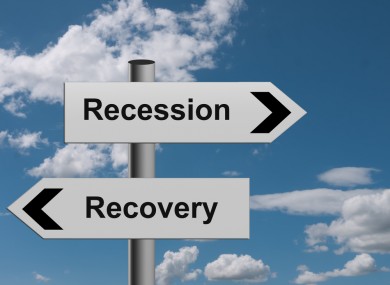What will the Irish Government target next to milk taxes from the Irish people
While income tax is unlikely to rise, the Government may target pensions, USC, DIRT and capital gains tax
There’s no avoiding it. On October 15th, Minister for Finance Michael Noonan will deliver yet another austerity budget. It will be the seventh budget since 2007 with a common theme – falling social welfare payments and rising taxes.
While most people might be saying “enough” by now, the Government has to make further cuts if it is to stay on course with its adjustment of up to €3.1 billion. So how might it be done?
Extending USC
The Government has stressed that no income tax hikes are on the agenda. However, Anne Bolster, tax director with PricewaterhouseCoopers (PwC), says it is possible that an increase in the Universal Social Charge (USC) might be on the way for PAYE employees earning more than €100,000. A surcharge of 3 per cent already applies to self-employed people earning above this level. As such, Bolster notes, such a move would be perceived to be equitable.
The Government has stressed that no income tax hikes are on the agenda. However, Anne Bolster, tax director with PricewaterhouseCoopers (PwC), says it is possible that an increase in the Universal Social Charge (USC) might be on the way for PAYE employees earning more than €100,000. A surcharge of 3 per cent already applies to self-employed people earning above this level. As such, Bolster notes, such a move would be perceived to be equitable.
 Tax on unearned income
Tax on unearned incomeAnother way of ensuring parity between those who are self-employed and those who are in the PAYE sector is to broaden the applicability of PRSI on unearned income.
Self-employed people have already been paying this, but from January 1st, 2014, it’s possible that everyone will have to pay tax on so-called passive income – which includes rental income, investment income, dividends and interest on deposits and savings.
“It would follow through that introducing PRSI for employees on other income would seem to be fairly fair,” says Bolster, although she adds that a “big question” would be how the tax might be implemented, given that PAYE employees typically – unless they own an investment property – do not file annual tax returns.
On the topic of PRSI, it might also be the case that the rate will be increased to 6 per cent for self-employed people, in return for better social welfare benefits.
Property tax
It was only introduced this year, but it was done so at a rate – 0.18 per cent – lower than that originally envisioned. So is there scope for an increase?
It was only introduced this year, but it was done so at a rate – 0.18 per cent – lower than that originally envisioned. So is there scope for an increase?
Padraig Cronin, tax partner with Deloitte, thinks so, but adds that it’s unlikely to come this year.
“It would be very easy to move it up,” he says, but adds that he doesn’t think the timing is right for an adjustment in the short-term.
“When higher rate income taxes are back down at 40 per cent, you could counter it by increasing property taxes.”
In any case, it will feel like the rate has increased next year given that it will be the first year that people have to pay the tax at the full rate.
DIRT
Tax on deposit interest has moved upwards steadily in recent years and, if the aforementioned application of PRSI on unearned income comes to pass, DIRT could be pushed up to 37 per cent.
DIRT
Tax on deposit interest has moved upwards steadily in recent years and, if the aforementioned application of PRSI on unearned income comes to pass, DIRT could be pushed up to 37 per cent.
Some 1.18 million Irish adults have €50 left after all bills are paid
A recent SURVEY FINDS


FINANCIAL POSITION IMPROVING FOR MANY, CREDIT UNION STUDY FINDS
The number of people with nothing left to spend at the end of the month once all essential bills have been paid has fallen sharply since last summer. Figures published by the Irish League of Credit Unions also suggest the level of disposal income is continuing to stabilise.
The figures indicate that the financial circumstances of many are improving, but nearly half of all adults are still struggling to pay their bills on time, with a growing number cutting back on food to make ends meet.
The credit unions’ latest “What’s Left” income tracking survey shows that 493,000 adults have nothing left at the end of the month once bills have been taken care of compared with 602,000 who said they were in the same financial position in June of last year.
 Disposable income
Disposable incomeThe survey has also found that disposable income has increased to €172 this month from €163 in May for an average adult.
The increase in monthly disposable income for working adults has gone up from €188 in May to €205, a jump of 9 per cent.
Mortgage repayments, the cost of utilities and the amounts people are paying to clear credit card debt have all fallen, which accounts for much of the increase in disposable income.
Struggling
The figures are improving but 1.18 million adults say they have €50 or less left at the end of the month once all bills have been paid while 40 per cent say they are struggling to pay their bills on time and have to sacrifice spending in areas such as health and life insurance to cover everyday expenses.
The figures are improving but 1.18 million adults say they have €50 or less left at the end of the month once all bills have been paid while 40 per cent say they are struggling to pay their bills on time and have to sacrifice spending in areas such as health and life insurance to cover everyday expenses.
“Once again we see further and continued signs of disposable income stabilisation into the second half of 2013,” said chief executive Kieron Brennan.
“There is a long way to go in terms of building confidence in the economy. It will be interesting to see where the Government has made cuts in the upcoming budget and how this will impact disposable income levels and indeed the finances of families around the country.”
Irish rural farmers fear for safety and want guns to protect themselves


EIGHT OUT OF TEN IRISH FARMERS SAY THEY SHOULD HAVE THE RIGHT TO OWN A GUN TO PROTECT THEMSELVES AND THEIR PROPERTY.
An Irish Examiner/ICMSA survey reveals the level of fear that exists in large parts of rural Ireland, with 81% of farmers polled in favour of gun ownership to combat rising crime levels.
The ICMSA said the findings were not surprising given that criminals were now targeting rural families and the scale of recent garda station closures.
The survey found support for gun ownership was higher amongst male farmers than female farmers. Farmers under 35 showed the least support for the provision. However, support for gun ownership was well over 70% across all age groups and irregardless of sex.
Gun ownership and the right to use it for self-defence has long been a contentious issue in rural Ireland.
It first hit the headlines in 2004 after traveller John ‘Frog’ Ward was shot dead by Mayo farmer Padraig Nally, for trespassing on his property. The farmers stated that he had acted in self-defence at all times.
Following a trial in 2005, Mr Nally was acquitted of murder but convicted of manslaughter. It was the first murder trial to be held in Mayo in nearly a century.
A retrial took place took place in December 2006, where Mr Nally was acquitted of manslaughter. In total, he served 11 months in prison.
During the trial, the Mayo farmer became something of a pin-up for rural homeowners and farmers arguing they should have the right to protect themselves using force, if necessary.
The issue also came back into focus earlier this year focus again this year following the decision by the Government to close 100 rural Garda stations across the country.
Of the regions surveyed for the study, Athenry in Galway expressed the most support for the measure at 98%. Skibbereen in Cork expressed the least support for the provision, with 69% stating they either agreed strongly or agreed with the measure.
 Amongst farmers who vote Sinn Féin, gun ownership received 100% support. This was followed by those who are undecided (87%), independent (85%), Fianna Fáil (83%) and Fine Gael (71%).
Amongst farmers who vote Sinn Féin, gun ownership received 100% support. This was followed by those who are undecided (87%), independent (85%), Fianna Fáil (83%) and Fine Gael (71%).
John Comber, ICMSA president said it was understandable that farmers feel they have the right to protect themselves.
Auld Arthur may call time on his big day as backlash gathers momentum
Company anxious celebration is recognised as expression of Irish conviviality
ARTHUR’S DAY CELEBRATES ITS FIFTH ANNIVERSARY ON THURSDAY.
It’s a celebration of “great people who make things happen”, suggest stout supporters of Arthur’s Day. Those calling for last orders on the boozy affair, meanwhile, insist it is a crass exploitation of a nation’s weakness for alcohol by a multinational corporation profiting handsomely from products linked to some of our society’s gravest ills.
The company, which records profits of more than €3 billion annually, is anxious its brainchild is recognised as a joyous celebration of the Irish pub, Irish conviviality and Irish culture. But no matter how loudly it urges people to “drink responsibly” and despite all its talk of the good things it does with (a tiny portion) of the money it makes, it is struggling to shake off some awkward truths. The most awkward one being the damage its products do.
Dangerous
More than two years ago, Minister for Health Dr James Reilly was told by experts that adults here drink “in a more dangerous way than nearly any other country”, while children “drink from a younger age” and “more than ever before”. He heard that alcohol was “a contributory factor in half of all suicides and it accounts for up to 10 per cent of bed days in hospitals, while alcohol-related road accidents cost an estimated €530 million in 2007”. Alcohol-related liver disease, meanwhile, has doubled over the past decade.
More than two years ago, Minister for Health Dr James Reilly was told by experts that adults here drink “in a more dangerous way than nearly any other country”, while children “drink from a younger age” and “more than ever before”. He heard that alcohol was “a contributory factor in half of all suicides and it accounts for up to 10 per cent of bed days in hospitals, while alcohol-related road accidents cost an estimated €530 million in 2007”. Alcohol-related liver disease, meanwhile, has doubled over the past decade.
That is the bigger picture. The smaller picture is not too pretty either. It is plain to see for anyone who has ever wandered the streets of Dublin, Cork or Galway, stepping over the rivers of urine and vomit which flow freely, and dodging the rows that break out as closing time looms just what impact Arthur’s Day can have. This viewwas confirmed by the Royal College of Physicians of Ireland yesterday, which reminded people that Arthur’s Day was behind a 30 per cent increase in ambulance call-outs.
In the doctors’ corner are musicians such as Christy Moore,Steve Wall and The Waterboys, while across a wider spectrum, calls for a boycott of Arthur’s drinks on the big day are growing, with even some Diageo people privately admitting that the hangover may not be worth it.
But just how much responsibility rests with the company? It has done all it can to insert an elaborate and expensive marketing wheeze into the Irish social calendar. But it doesn’t hold people down and force the black stuff down their throats with a funnel.
Choices
People make choices. People will choose to go out on Thursday. And some of them will choose to get drunk – and
some may possibly end up in life-threatening situations as
a result.
People make choices. People will choose to go out on Thursday. And some of them will choose to get drunk – and
some may possibly end up in life-threatening situations as
a result.
The drink-related problems besetting the country willcontinue until those who can make a more tangible difference do something.
The Government said there would be an overhaul of legislation once the National Substance Misuse Strategy steering group published its report 18 months ago, with controls on pricing and advertising and greater enforcement of existing laws aimed at curbing problem drinking.
Nothing has happened yet and until it does, the palaver about Arthur will be nothing more than a sideshow to be forgotten as soon as the bad Friday hangover lifts.
Young Irish scientists win the top award in Prague at European union event
Irish projects outperform all other countries.
Right Pic. (From left) Ciara Judge, Sophie Healy-Thow and Emer Hickey, 2013 BT Young Scientist and Technology Exhibiton winners and now winners of a first prize at the European Union Contest for Young Scientists.
Ireland’s young scientists have done it again, winning a major prize at the European Union Contest for Young Scientists in Prague today.
Ciara Judge, Emer Hickey and Sophie Healy-Thow won a first prize in the biology section at the competition in Prague.
Last January their project on plant germination won the top prize in the 2013 BT Young Scientist and Technology Exhibition at the RDS.
Their win entitled them to compete in the European Contest representing Ireland. The competition was intense with 120 students from 38 countries taking part. Their prize was € 7,000 plus an all expenses paid trip to the London International Youth Science Forum.
“In 25 years of competing at the EU competition, Ireland has now taken home the top honours 15 times, out-performing all other countries,” said BT’s chief executive officer Colm O’Neill.
The three students are transition years attending Kinsale Community College, Cork.
The 2014 BT Young Scientist & Technology Exhibition will take place in the RDS, Dublin from January 8th – 11th 2014. Students are being urged to get their entries in by the 2nd October 2013 deadline. For more information on the exhibition, log onto http://www.btyoungscientist.ie.
How old is the moon? Scientists bring forward age 100 million years


Rock samples from Apollo 16 mission finally analysed show the moon is millions of years younger than previously thought.
The moon is much younger than scientists have been led to believe, according to researchers analysing samples taken from the Apollo 16 mission.
The prevailing theory surrounding the creation of the moon is that a Mars-sized body known as ‘Theia’ collided with a newly formed proto-earth approximately 4.56 billion years ago, shortly after the formation of the solar system.
The massive impact caused melted material to break off into pieces in space, before eventually re-joining to form the moon.
As the Moon cooled, this magma ocean solidified into different mineral components, the lightest of which floated upwards to form the oldest layer of crust.
New analysis of material collected from it’s surface suggests that the moon is 100 million years younger than previously thought.
A piece of lunar rock sample gathered in the Apollo 16 mission of 1972 has been analaysed by researchers at the University of Copenhagen, using newly refined techniques to assess the age of the sample.
The team of scientists, led by James Connelly from the Centre for Star and Planet Formation, examined the isotopes of the elements lead and neodymium to place the age of a sample of a FAN at 4.36 billion years.
This is significantly younger than earlier estimates, which put the moon’s age as nearly as old as the solar systems – 4.567 billion years.
Mr Connelly said: “Although the samples have been carefully stored at NASA Johnson Space Center since their return to Earth, we had to extensively pre-clean the samples using a new method to remove terrestrial lead contamination.
“Once we removed the contamination, we found that this sample is almost 100 million years younger than we expected.”
The new, younger age obtained for the oldest lunar crust is similar to ages obtained for the oldest terrestrial minerals – zircons from Western Australia – suggesting that the oldest crust on both Earth and the Moon formed at approximately the same time.





No comments:
Post a Comment